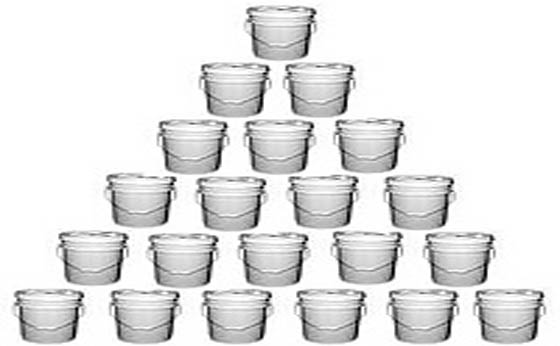How Much Survival Food Is Enough – How Much Do I Need?

How much survival food? There are lots of posts related to preparedness food storage on this site! Logically the topic is among the top interests for the preparedness-minded. However it is a good question to ask… How much food?
Survival food storage is an insurance policy of sorts. For emergency, disaster, or worse.
The amount of food that any one person chooses to store is a wide ranging thing! How much food is first related to one’s risk tolerance. One’s perception of a disaster’s likelihood. Motivation. One’s resources.
Common sense tells us that short term disruption scenarios, (“normal” emergencies?) are probably more likely to occur than some of the greater disaster scenarios. So one might think that preparing for “normal” emergencies is good enough.
On the other hand, although a SHTF scenario may seem less likely, if it were to happen, it will impact in a much more severe way. And having not prepared for that, will or could become life threatening.
People look at this from one extreme to another, and all in-between.
So, how much survival food is enough?
Well, I’ll throw out a few thoughts…
3 Days?
I’m talking about food for a typical vehicle car-kit. Or a 72-hour-kit. Bug-out-bag kit. The generally accepted rule-of-thumb is 3 days worth of food (calories), for each person the kit is intended to supply.
The idea with this… To have enough food that would cover the reasonable amount of time that it might take for you to get from point-A to point-B. The presumption being that point-B will be equipped with food and supplies.
[ Read: Survival Kit ]
But how much survival food do I need at home?
Again, it depends on your personal risk-tolerance. Sadly, most non-preparedness-minded people might only have just several days, maybe a week (two tops – but doubtful) of food at home. I believe statistics indicate closer to just several days on average.
So, I suggest building it in steps. At least up until you’ve reached your personal comfort zone.
30 Days of Survival Food is good for most
In my opinion, a good round number is a solid 30-day supply for every member of the household. That will cover 90% of all “typical” emergencies. Most of these events are regional, and generally recoverable in a reasonable amount of time.
3 Months
For enough food supply to ensure against those disasters which may not recover in a reasonable amount of time. The next step is a solid 3-month supply for every member of the household.
While a 30 day supply is very easy to do, a 3 month supply will require a little bit more effort. And cost. However it’s still very easy. When you’re building your food storage, concentrate on bulking up on the foods that you normally eat.
1 Year
The next step is a Big One.
Once you’ve stocked up a 3-month supply of food (at least 2,000 calories per day per person), and if you feel the necessity, the next step to focus on is 1-year.
A 1-year food storage plan will cause you to start thinking more seriously about additional aspects. Shelf life. The types of foods. How they’re stored. How they’re preserved. The variety of food. Foods that are more fitting for long-term storage. A balanced approach. Food rotation techniques, and more…
Stepping up to a 1-year plan is more difficult. It will require you to do some research to decide what will be successful for you, and the right way to go about it.
So why would anybody want a 1-year supply of food? Isn’t that way over-the-top?
Unfortunately, many people today will think that you’re a bit ‘crazy’ if they know you’ve stored a 1-year supply of food!
It’s too bad that this is how it is… sad really. By attempting to be responsible for yourself, you’re potentially looked at as a nut case. So… don’t tell anyone.
Again, why would anyone need a 1-year food supply?
To survive a SHTF scenario.
Could it happen?
…absolutely yes.
Is it likely to happen?
…maybe, maybe not.
Maybe a question you should be asking yourself instead is, “Is my life worth a 1-year supply of food?”
“What is a SHTF scenario, and how would it affect my ability to get food from the grocery store or from an organized relief effort?”
A SHTF scenario is a generally used acronym for “$hit Hit The Fan”. I tend to use it to imply some sort of huge wide-ranging and deeply impacting disaster.
It is one where some, or many, of the interwoven systems that enable our modern-day living, will break down to an extent where life as we know it becomes societal chaos. It is a collapse scenario whereby food (or lots of) will run out of the grocery store, not to be re-stocked. A scenario that affects more than just a local region. Sufficient in magnitude to last for a long time… long enough for people to get very desperate and hungry.
It may seem very unlikely that a SHTF scenario would ever occur. And maybe that’s correct. And therefore one would never need to keep a 1-year supply of food. But the thing is, we get lulled into a sense of security because it’s never happened to us before. Therefore, it will never happen to us…right?
It is a risky proposition to assume that everything will always remain as it is.
2 Years
So, is 1-year enough for a SHTF wide ranging breakdown of our food supply? Maybe. But in a worst-case scenario, I don’t believe that’s enough food. Here’s why…
If we had to become truly self-reliant (for whatever reason – which is beyond the scope of this article), a major source of food will be whatever we can produce ourselves or within our immediate local community.
I wonder how many people who have stored 1-year of food will be successful the following summer growing a garden produces enough to keep them going for yet another year? What if there’s failure? (By the way, be aware of the best foods for a survival garden).
[ Read: Garden Vegetable Calories List ]
[ Read: You Won’t Be Eating Much Meat After SHTF ]
It seems to me that in order to provide yourself a cushion for problems like this, a 2-year supply of food should be much better. This is why it’s so important to start experimenting with gardening (and its problems), and food preservation techniques, BEFORE you need to rely on it for survival. Don’t expect that your first crop is going to be entirely plentiful.
So we’ve come from a 3 day supply of food, all the way to a 2-year supply of food. How much survival food is enough? That’s entirely up to you!
